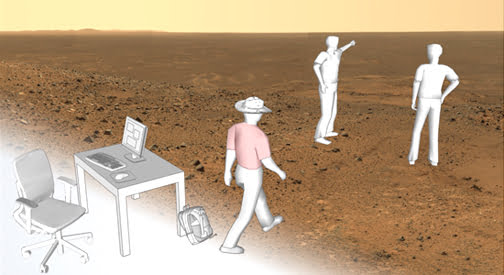What’s the difference between watching the moon landing on TV and being Neill Armstrong himself? To answer that question – and others – NASA has been working on technology that will give its engineers the experience of walking on the surface of other planets while sparing them the lengthy spaceflight to get there.
On Sept. 12-13, Dr. Jeff Norris will be giving a free lecture titled “Telexploration: How Video Game Technologies Can Take NASA to the Next Level.” In the lecture, Norris will give a detailed overview of the progress NASA has made with the improvement of virtual reality technology as well as explaining what future plans may be. The lecture is part of the twice-monthly Theodore von Kármán Lecture Series, named after JPL’s founder.
Dr. Norris has been a top scientist at NASA for years working on mission control, software and robotics. He has been at the head of numerous projects aimed at improving the way scientists and engineers visualize and interact with extraterrestrial environments through robotics. He is also famous for his public speaking engagements where he demonstrates everything from robots to augmented reality live on stage.
“How do we make people better decision makers when they are controlling spacecraft?” Norris asked. “By making them feel like they’re really there.” Norris has started a new office at NASA called the Mission Operations Innovations Office and its chief goal is the transformation of the way NASA missions are controlled. The Telexploration Project is a very important step towards that goal. It aims to create virtual environments which are much more immersive to the controller than anything seen before.
Humans naturally possess a certain amount of spatial intelligence that helps them to maneuver through the physical world with ease. Norris explained that when a person’s perception of an environment is reduced down to something like the little screen of a laptop, their ability to intuitively navigate that space plummets.
“We need to be able to get a sense of shape to our environment,” Norris said. “The data we’re working with now feels insufficient.”
The Telexploration Project aims at creating technology that would render this loss of spatial intuition almost unnoticeable for those controlling robots and spacecraft remotely.
But virtual reality technology does present its set of problems. For instance, head-mounted displays tend to produce motion sickness and headaches for some people, which virtually eliminates their ability to work on projects that would require hours of constant VR interfacing. Head-mounted displays can also be isolating and only deliver virtual reality to one person at a time, limiting people’s ability to work together. Building something like a large room with a cylindrical screen or “holodeck” would allow multiple people in on the same simulation but is unfeasible in terms of portability and affordability.
In light of all this, NASA has turned to the video game industry for partnership in getting the technology needed to make its VR goals a reality. It’s an industry that has worked for years to make people feel immersed in virtual environments at an affordable price.
“We don’t want to build a giant million dollar holodeck,” said Norris. “We want to build a million little holodecks.”
Devices such as the Oculus Rift, a head-mounted VR display, bring a lot to the table in terms of portability and affordability. The goal is to create immersive VR technology that can be transported easily and used by many people at once.
It is often the case that cutting edge technology from NASA eventually trickles down into the mainstream market and Norris predicts that this will be no different. Not only will NASA scientists and engineers be able to explore mars with VR technology but it is expected that the general public will as well.
“I think this is going to revolutionize the way we work, play, and explore,” he said. “I would love to find ways to make everyone feel like they are a part of this journey. We want people to be able to go alongside astronauts and robots.”
The first lecture will be on Sept. 12 at 7 p.m. in the von Kármán Auditorium at JPL located at 4800 Oak Grove Drive in Pasadena. The second lecture will be on Sept. 13 at 7 p.m. in the Vosloh Forum at Pasadena City College on 1570 E. Colorado Blvd. in Pasadena. Both lectures are free to attend.
For more information, visit http://www.jpl.nasa.gov/events/lectures.php.

